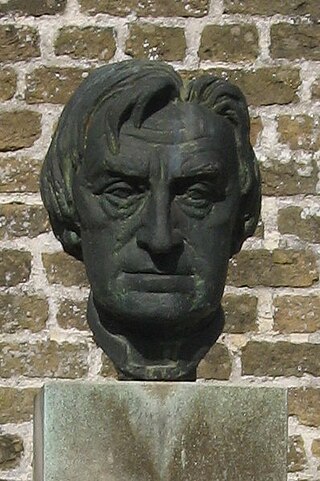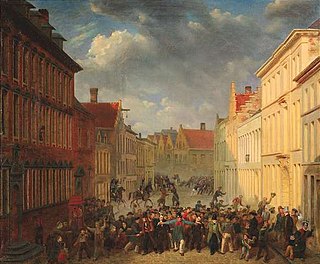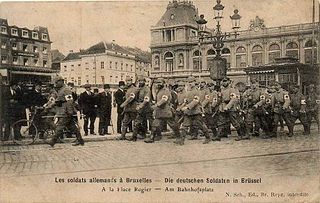Related Research Articles

Flanders is the Dutch-speaking northern portion of Belgium and one of the communities, regions and language areas of Belgium. However, there are several overlapping definitions, including ones related to culture, language, politics, and history, and sometimes involving neighbouring countries. The demonym associated with Flanders is Fleming, while the corresponding adjective is Flemish, which can also refer to the collective of Dutch dialects spoken in that area, or more generally the Belgian variant of Standard Dutch.

Leopold III was King of the Belgians from 23 February 1934 until his abdication on 16 July 1951. At the outbreak of World War II, Leopold tried to maintain Belgian neutrality, but after the German invasion in May 1940, he surrendered his country, earning him much hostility, both at home and abroad.

Albert I was King of the Belgians from 23 December 1909 until his death in 1934. He is popularly referred to as the Knight King or Soldier King in Belgium in reference to his role during World War I.

Baudouin was King of the Belgians from 17 July 1951 until his death in 1993. He was the last Belgian king to be sovereign of the Congo, before it became independent in 1960 and became the Democratic Republic of the Congo.

The monarchy of Belgium is the constitutional and hereditary institution of the monarchical head of state of Belgium. As a popular monarchy, the Belgian monarch uses the title king/queen of the Belgians and serves as the country's head of state and commander-in-chief of the Belgian Armed Forces.

Albert II is a member of the Belgian royal family who reigned as King of the Belgians from 9 August 1993 until his abdication on 21 July 2013.

The Flemish Movement is an umbrella term which encompasses various political groups in the Belgian region of Flanders and, less commonly, in French Flanders. Ideologically, it encompasses groups which have sought to promote Flemish culture and the Dutch language as well as those seeking greater political autonomy for Flanders within Belgium. It also encompasses nationalists who seek the secession of Flanders from Belgium, either through outright independence or (re)unification with the Netherlands.

The Yser Towers are a monument complex near the Yser river at Diksmuide, West Flanders in Belgium. The first tower was built in 1928–30 to commemorate the Belgian soldiers killed on the surrounding Yser Front during World War I and as a monument to Christian pacifism. However, it subsequently became an important political symbol for the Flemish Movement and was destroyed in 1946 as a result of its association with Flemish nationalist collaboration in German-occupied Belgium in World War II. The current tower was rebuilt alongside the remains of the original and copied its design. It was finished in 1965. It remains a site of political significance to Flemish nationalists and is the center for their annual Yser Pilgrimage (IJzerbedevaart).

Cyriel Verschaeve was a Flemish nationalist priest and writer who collaborated with the Nazis during the Second World War. He was recognised as the spiritual leader of Flemish nationalism by the ideology's adherents and a Nazi propagandist.
The 2007–2008 Belgian government formation followed the general election of 10 June 2007, and comprised a period of negotiation in which the Flemish parties Flemish Liberal Democratic, Christian Democratic and Flemish (CD&V) and New Flemish Alliance (N-VA), and the French-speaking parties Reformist Movement (MR), Democratic Front of Francophones (FDF) and Humanist Democratic Centre (CdH) negotiated to form a government coalition. The negotiations were characterized by the disagreement between the Dutch- and French-speaking parties about the need for and nature of a constitutional reform. According to some, this political conflict could have led to a partition of Belgium.

Prince Baudouin of Belgium was the first child and eldest son of Prince Philippe, Count of Flanders, and his wife, Princess Marie of Hohenzollern-Sigmaringen. After Baudouin's death, his younger brother eventually became heir presumptive after the death of their father, and later succeeded their uncle Leopold II as Albert I of Belgium.

Orangism was a political tradition in Belgium that supported its reintegration into the short-lived United Kingdom of the Netherlands (1815–1830) under the rule of the Dutch House of Orange. It existed principally in the 1830s and 1840s.

The royal question was a major political crisis in Belgium that lasted from 1945 to 1951, coming to a head between March and August 1950. The question at stake surrounded whether King Leopold III could return to the country and resume his constitutional role amid allegations that his actions during World War II had been contrary to the provisions of the Belgian Constitution. The crisis brought Belgium to the brink of a civil war. It was eventually resolved by the abdication of Leopold in favour of his son King Baudouin in 1951.

The Yser Medal was a Belgian campaign medal of World War I, established on 18 October 1918 to denote distinguished service during the 1914 Battle of the Yser in which the Belgian Army stopped the German advance of the German invasion of Belgium.

August Borms was a Flemish nationalist politician active in Belgium during the first half of the twentieth century. He belonged to the far-right of the Flemish movement. Borms collaborated with Germany during both the First and Second World Wars and was sentenced to death at the end of each conflict. He was not however executed until 1946, having had his sentence quashed the first time.

The history of Belgium in World War I traces Belgium's role between the German invasion in 1914, through the continued military resistance and occupation of the territory by German forces to the armistice in 1918, as well as the role it played in the international war effort through its African colony and small force on the Eastern Front.

The Yser Front, sometimes termed the West Flemish Front in British writing, was a section of the Western Front during World War I held by Belgian troops from October 1914 until 1918. The front ran along the Yser river (IJzer) and Yser Canal (Ieperlee) in the far north-west of Belgium and defended a small strip of the country which remained unoccupied. The front was established following the Battle of the Yser in October 1914, when the Belgian army succeeded in stopping the German advance after months of retreat and remained largely static for the duration of the war.

In the history of Belgium, the period from 1789 to 1914, dubbed the "long 19th century" by the historian Eric Hobsbawm, includes the end of Austrian rule and periods of French and Dutch rule over the region, leading to the creation of the first independent Belgian state in 1830.

The German occupation of Belgium of World War I was a military occupation of Belgium by the forces of the German Empire between 1914 and 1918. Beginning in August 1914 with the invasion of neutral Belgium, the country was almost completely overrun by German troops before the winter of the same year as the Allied forces withdrew westwards. The Belgian government went into exile, while King Albert I and the Belgian Army continued to fight on a section of the Western Front. Under the German military, Belgium was divided into three separate administrative zones. The majority of the country fell within the General Government, a formal occupation administration ruled by a German general, while the others, closer to the front line, came under more repressive direct military rule.

The King Albert I Memorial, also named the King Albert I Monument is a memorial at the Belgian coastal city of Nieuwpoort. It is located right outside the old town, on the right bank of the Yser river at the lock complex Ganzepoot. The monument was erected in 1938 after a design of Julien de Ridder and honours both King Albert I of Belgium and the Belgian troops at the time of the First World War.
References
- ↑ According to the Constitution, the title of the Belgian monarch is "King of the Belgians" (Koning der Belgen) rather than "King of Belgium" (Koning van België) to reflect the monarchy's popular character.
- ↑ The letter's date, 11 July, was the anniversary of the Battle of the Golden Spurs of 1302, a key historical reference for Flemish identity. Today the same date is celebrated annually as the Day of the Flemish Community.
Notes
- ↑ Van Goethem 2010, p. 113.
- 1 2 Witte et al. 2009, p. 171.
- 1 2 Van Goethem 2010, p. 114.
- ↑ Van Goethem 2010, p. 115.
Bibliography
- Van Goethem, Herman (2010). Belgium and the Monarchy: From National Independence to National Disintegration. Brussels: UPA. ISBN 9789054876984.
- Witte, Els; Craeybeckx, Jan; Meynen, Alain (2009). Political history of Belgium from 1830 onwards (New ed.). Brussels: ASP. ISBN 978-90-5487-517-8.